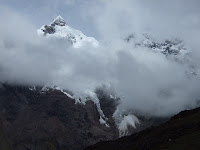










As an alternative to the Classic Inka Trail which has high numbers of other trekkers I decided to take the Dragoman ´Community Trek¨ as it would be just our group walking the trail and some of the money from the trek is donated towards community projects in the villages we visit high in the Andes. These communities are often poor with very little / no infrastructure. I am going to allow the photographs to portray the details of the trek but I will give you some background information / an oversight.
Over 4 days we walked through the Andes, over 4800 metres in places through rain, wind, snow and sunshine. The Andes cover 7500km from Argentina to Southern Panama and are 250Km wide (little knowledge nugget for you). The air was thin and some people faired better than others with the altitude. Personally I was mostly ok, finding the Coca leaves very helpful in times of difficulty. It was a challenging trek but beautiful at the same time. We camped overnight at various remote Andean villages. By remote, I mean it takes up to 5 hours to walk to and from the nearest road! Some of the children walk for 2 hours to get to the nearest village school! The teacher will often be at the end of training and although paid by the government for a 5 day week will get to the village late on Monday and leave early on Friday to get home.
The main crops grown are potatoes and apparently Peru has 3800 varieties of potato. They keep Llamas / Alpakas for selling on and for wool. They keep sheep and cows for food and donkeys /mule for tourism and to transport goods to and from the villages. Donkeys / Mule can carry more weight than Llama but in comparison to the Llama they eat more and have a greater deleterious impact on the trails.
The people are very shy and many of the adults speak only Quechua and limited or no spanish. The children learn spanish in school. They often live in poverty and malnutrition is high. NGO´s assist with health and dental care. The children wear traditional Andean clothing, uninfluenced by modern life unlike most places I have seen to date in Peru. They weave and make ceramics for their own use and for selling to tourists and at every village we came to, we were greeted with a line of women and children offering us their items.
As visitors to the villages, we tool gifts of paper, pens and such like to give to the schools. At the most remote village Dragoman had organised hot cholcolate and bread for the school children which you can see us handing out before our second days trek from the photos. The walk consisted of early mornings, retiring exhausted to sleeping bags after dinner, no showers but our guides looked after us well. The donkeys / mule from the villages carried all the equipment and food and the accompanying cooks and guides from the villages made us great meals along route and were great company.
We passed through magnificent landscapes and scenery of lakes, waterfalls, quaint little houses / villages, glaciers and observed varying Andean flora and fauna.
Our last day led us to a campsite with thermal baths and boy was it good to relax our tired and aching bodies in the hot steaming healing sulphur whilst the surrounding Andean temperature at dusk significantly dropped around us.
It was a beautiful and humbling experience.
In day 4 we set off at 3am on a 3hour bus ride along a bumpy mountainside road to Ollantaytambo, a town and archaeological site 60kms Northwest of Cusco which served as a stronghold to the Inkas during the spanish conquest before the Inkas fled to the jungle (and Macch Picchu). However from 1532 there was a civil war and the spaniards took advantage of this, eventually conquering the Inkas.
Ollantaytambo contained religious, astronomical, administrative and housing complexes with areas for both agriculture and livestock. It is a fascinating place. There are many carvings in rocks which point to stars. If you look to one of the surrounding mountains you can see the profile of an Inkan face shape on the edge of the mountain. On June 25th Winter Solstice, the sun rises exactly at this point in the mountainside and not only that, the sun ray shines in a straight line towards the city in alignment with a doorway of the ruins!
Agriculture was the main activity for the Inkas so a good calender was necessary for planting, harvesting times and to know when El Nino was due. There is a stone calender at the ruins which was used as a sun dial.
No comments:
Post a Comment